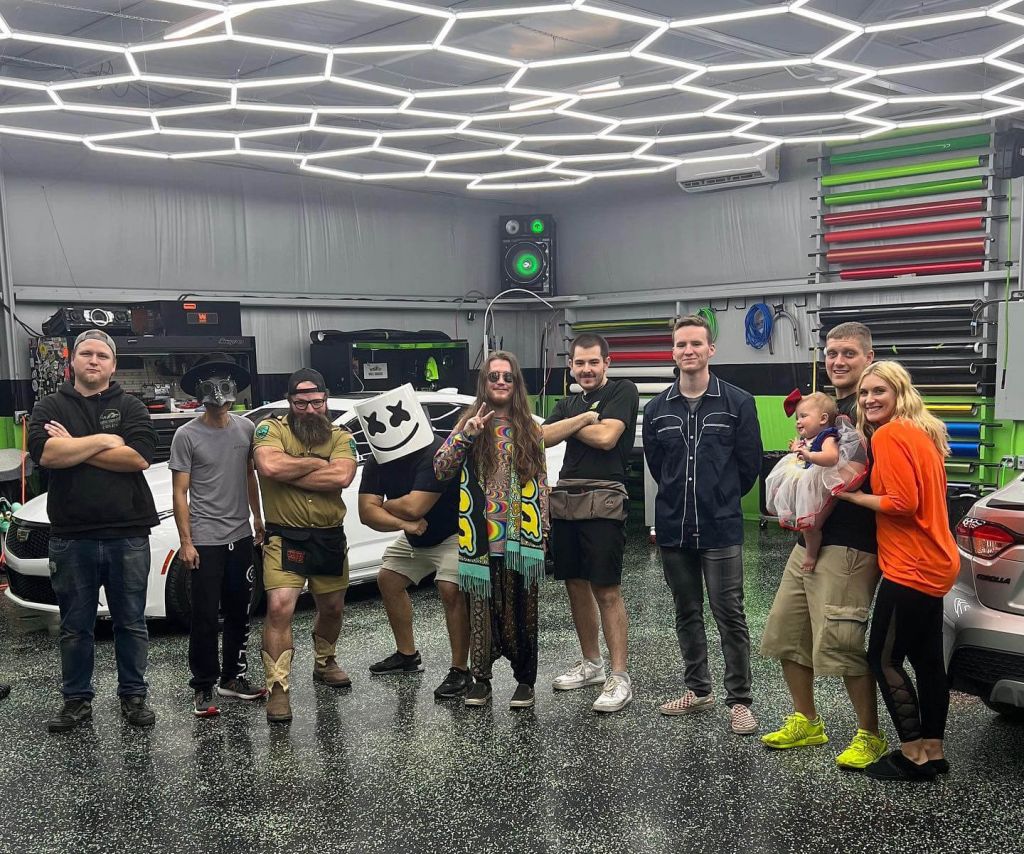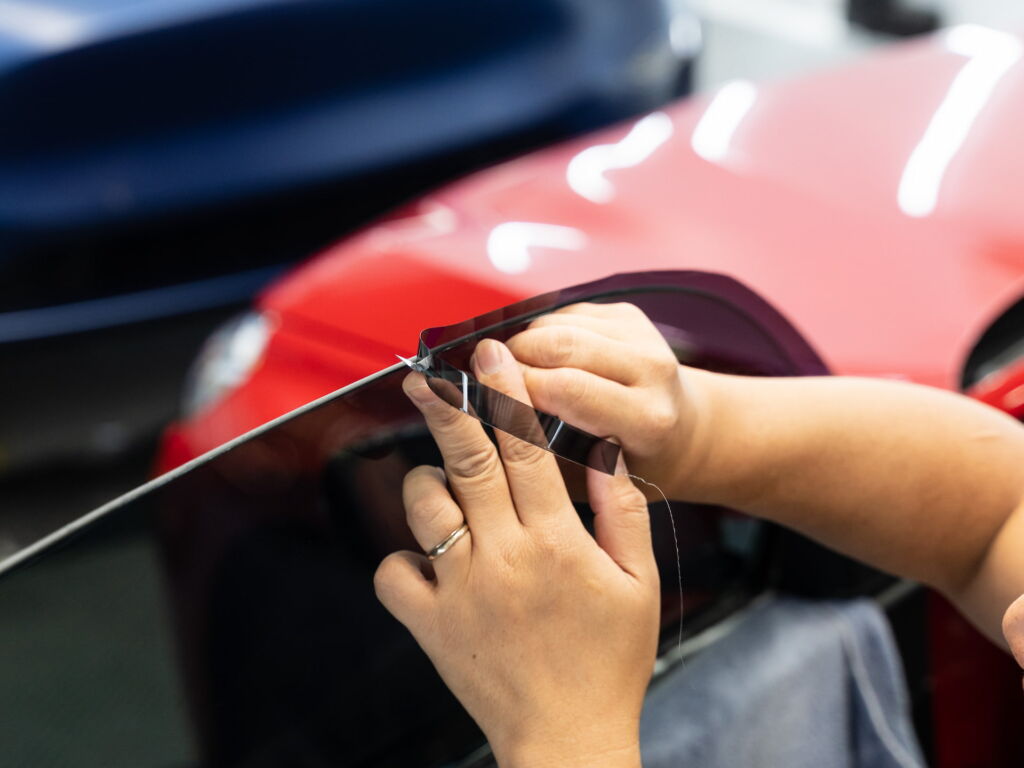Tinting your car windows can transform both the appearance and practicality of your vehicle. Whether you’re aiming for increased privacy, reduced glare, or a sleeker look, window tinting remains one of the most popular modifications car owners pursue. Yet one question frequently arises: How long does it take to tint a car?
In this comprehensive guide, we’ll dive into the variables that affect tinting times, the typical timeline for car window tinting, and practical tips for ensuring a flawless end result. By the end of this article, you’ll have a clear understanding of what to expect when scheduling a tinting appointment, including why Shell Shocked Wraps is your best bet for a professional finish.

Table of Contents
Toggle1. Why Car Window Tinting Matters
Car window tinting provides a multitude of benefits that go beyond appearance. Here are a few crucial advantages:
- Heat Rejection: High-quality tints can significantly reduce the heat entering your car, making your driving experience more comfortable, especially during hot summers.
- UV Protection: Tinted windows help block harmful UV rays, safeguarding your interior from fading and protecting your skin from prolonged exposure.
- Privacy and Security: Darker tints offer a sense of privacy, deterring prying eyes and helping to conceal valuables within the car.
- Reduced Glare: Whether it’s from the sun or headlights at night, window tint cuts down on glare and helps improve visibility.
- Enhanced Aesthetics: Finally, tints just look good. A sleek tint job elevates the look of any vehicle, giving it a sophisticated edge.
With these benefits in mind, many drivers are eager to schedule a tinting appointment. However, the first question often asked is: How long does it take to tint a car? Let’s explore the factors that influence tint installation time.
2. Factors That Affect Car Tinting Time
Various aspects determine how long it takes to tint a car. While many installers can complete the job in a standard timeframe, it’s helpful to know what variables can shorten or lengthen the process:
- Number of Windows
- A two-door coupe with only two main side windows and a rear window can be tinted faster than a four-door sedan with six windows (front, rear, and four side windows).
- Complexity of the Window Shapes
- Certain cars have unusual or highly curved windows that require more precise cutting and fitting of the film. These shapes can take longer to tint properly, especially if the film has to be molded carefully to avoid bubbles.
- Type and Quality of Tint Film
- Premium or specialized films (like ceramic tints) can be trickier to install compared to more standard, dyed films. The composition might demand extra time for accurate alignment and application.
- Experience of the Installer
- A professional with years of experience and refined techniques will likely complete the job faster than someone new to tinting. Expertise ensures efficiency without compromising quality.
- Environmental Conditions
- The humidity and temperature of the installation area can affect how the tint adheres. If you’re installing in a humid or very cold environment, it can extend drying times or even require special conditions for optimal bonding.
- Preparation and Cleaning
- Preparing the glass is a critical step—any dust, grease, or residue can lead to bubbles and premature peeling. Proper cleaning is a must, and thoroughness might add extra minutes or hours, depending on the car’s condition.
Being aware of these factors can help you set realistic expectations. Generally speaking, though, there’s a typical range for the entire process.
3. How Long Does It Take to Tint a Car? Typical Timelines
The General Range
Under most circumstances, car window tinting takes about 2 to 4 hours. This timeframe includes cleaning the windows, cutting the film, applying it, and smoothing out any bubbles. However, you could see variations on either side of this average based on the factors described above.
- 2-Door Coupe: 1.5 to 2 hours
- 4-Door Sedan: 2 to 3 hours
- SUV or Minivan: 3 to 4 hours (or more, depending on window count and complexity)
Post-Installation Drying Times
After the film is applied, there is a critical curing period. Most professionals recommend:
- Avoid rolling down windows for at least 24-48 hours.
- Full curing can take 2 to 7 days, depending on the climate. During this curing phase, the film might appear hazy; that’s normal and will subside as the moisture evaporates.
It’s essential not to accelerate the process by applying heat (like a hairdryer) unless specifically instructed by your installer. Rushing curing can cause premature bubbling or peeling.
4. DIY vs. Professional Installation
In the quest to save money, some car owners contemplate a do-it-yourself approach. While it might appear straightforward—especially with pre-cut films available online—there are reasons why professionals exist:
- Learning Curve: Perfecting tint installation takes practice. Beginners often struggle with bubbles, creases, and misalignment.
- Equipment: Proper tools (squeegees, heat guns, specialized knives) are crucial for a clean job.
- Warranty and Quality: Professional shops like Shell Shocked Wraps often provide warranties for labor and materials. DIY efforts seldom come with such peace of mind.
- Time Considerations: A task that takes 2-4 hours for a professional could take an entire weekend for a novice, especially when redoing failed attempts.
If your priority is saving time and ensuring a high-quality result, professional installation is worth the investment. Plus, professionals can tailor the tint to meet local regulations, ensuring your car remains road-legal.
5. Tinting Laws and Regulations
Before booking an appointment or starting a DIY project, familiarize yourself with your region’s tint laws. Different states and countries have specific regulations on:
- Visible Light Transmission (VLT): This is the percentage of light that passes through your windows. The lower the VLT, the darker the tint.
- Windshield Tinting: Many places restrict how dark your windshield can be tinted or how far the tint can extend from the top.
- Reflectiveness: Some jurisdictions limit reflective tints.
Research is vital to avoid fines and the hassle of removing non-compliant film. If you’re unsure, consult resources like https://www.dps.texas.gov/section/vehicle-inspection/window-tinting-standards or ask your local installer for guidance. A reputable shop will ensure your chosen tint adheres to the regulations in your area.
6. What to Expect on the Day of Installation
1. Inspection and Consultation
Upon arrival, the tint technician will typically inspect your car and discuss tint options. You’ll choose the film type (dyed, metallized, ceramic, hybrid, etc.) and the shade, ensuring it complies with legal standards.
2. Thorough Cleaning
Cleanliness is paramount. The technician cleans each window inside and out to remove contaminants that could jeopardize a smooth application.
3. Measuring and Cutting
Professionals either use precut patterns or cut film by hand, customizing each piece to the shape of your windows.
4. Applying the Film
The technician sprays a specialized solution on the glass and film, then carefully places the tint, squeegeeing out bubbles. This step demands precision, experience, and patience.
5. Final Inspection
Once the tint is in place, there’s a quality check. They’ll ensure no edges are peeling or misaligned. You’ll also receive post-care instructions—typically focusing on drying times and cleaning guidelines.
Overall, if you book an appointment with Shell Shocked Wraps, you can expect clear communication, professional workmanship, and a tint job that matches your preferences perfectly.
7. Caring for Your Newly Tinted Windows
Your newly tinted windows are an investment, and proper care extends their lifespan. Here’s how:
- Avoid Rolling Down the Windows: As mentioned, keep your windows up for 24-48 hours post-installation. This helps the adhesive bond fully.
- Gentle Cleaning Products: Use mild, ammonia-free cleaners to avoid damaging the tint. Ammonia can degrade the film and cause discoloration.
- Soft Cloth or Microfiber Towel: Abrasive materials can scratch the tint. Always use soft towels or microfiber to clean and dry your windows.
- Park in Shade When Possible: Prolonged exposure to intense sunlight can speed up tint fading. Whenever you can, park in shaded areas or garages.
- Perform Regular Inspections: If you notice bubbling, peeling, or color change, contact your installer. Early detection can sometimes save the tint from worsening damage.
8. Frequently Asked Questions (FAQ)
Q1: Can I wash my car immediately after tinting?
A: Yes, as long as you avoid rolling down the windows. Washing the exterior won’t affect the interior tint film.
Q2: What if I see small bubbles post-installation?
A: Small water pockets can form as the film cures. They usually disappear over a few days. If they persist longer than a week, contact your installer.
Q3: How do I choose the right film?
A: Consider factors like budget, desired appearance, and level of heat or UV rejection. Talking with a reputable shop helps you find a film tailored to your needs.
Q4: Is tinting legal in all states?
A: Tinting is legal but regulated. Each state (and country) has different limits on the darkness and reflectiveness allowed.
Q5: Does tinting affect resale value?
A: Quality tint installation can enhance resale value by improving aesthetics and protecting the interior. Poorly installed or overly dark tints may deter some buyers.
9. Why Choose Shell Shocked Wraps
At Shell Shocked Wraps, we’re committed to providing top-notch tinting services that not only elevate the look of your vehicle but also enhance your driving experience. Here’s why our clients trust us:
- Expertise: Our certified professionals have years of experience in window tinting and vehicle wraps, ensuring a perfect application every time.
- Quality Films: We use industry-leading tint films known for their durability, UV protection, and aesthetic appeal.
- Compliance: Unsure about local regulations? We’ll guide you in selecting the right shade and reflectiveness level that keeps you on the right side of the law.
- Customer Service: From the moment you contact us until you drive away with your newly tinted car, our team is there to address questions, offer advice, and ensure you’re 100% satisfied.
Feel free to reach out to us at Shell Shocked Wraps to schedule an appointment or request a quote. Our mission is to provide results that exceed your expectations.
10. Final Thoughts
How long does it take to tint a car? In most cases, you can expect anywhere from 2 to 4 hours for professional tinting, depending on the number of windows, vehicle size, and tint film type. Beyond time considerations, quality is crucial. A rushed or poorly executed job may lead to bubbles, creases, and possible legal issues.
By choosing a reputable shop like Shell Shocked Wraps, you can ensure your tint is installed efficiently, looks incredible, and adheres to local regulations. Don’t forget to properly care for your new tint by avoiding harsh cleaning products and rolling down your windows prematurely. With the right maintenance, your tinted windows can stay in pristine condition for years to come.
If you have any more questions about car window tinting or want to schedule an installation, contact Shell Shocked Wraps today. Our experienced team is here to transform your vehicle—one window at a time.
